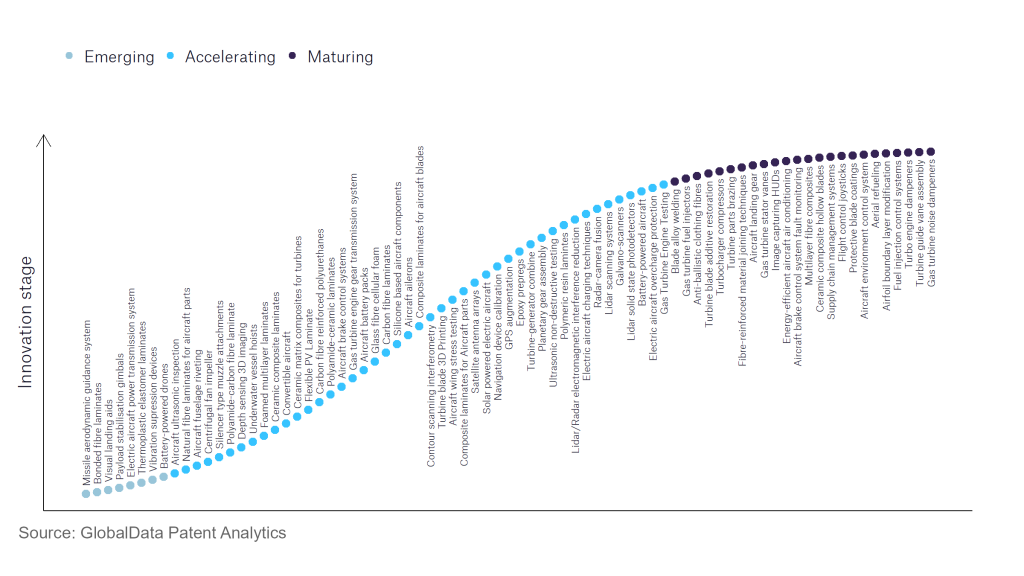The aerospace and defence industry continues to be a hotbed of innovation, with activity driven by the uptake of advanced technology, and growing importance of technologies such as hypersonics and advanced materials. In the last three years alone, there have been over 174,000 patents filed and granted in the aerospace and defence industry, according to GlobalData’s report on Innovation in Aerospace, Defence & Security: Ultrasonic non-destructive testing.
However, not all innovations are equal and nor do they follow a constant upward trend. Instead, their evolution takes the form of an S-shaped curve that reflects their typical lifecycle from early emergence to accelerating adoption, before finally stabilising and reaching maturity.
Identifying where a particular innovation is on this journey, especially those that are in the emerging and accelerating stages, is essential for understanding their current level of adoption and the likely future trajectory and impact they will have.
180+ innovations will shape the aerospace and defence industry
According to GlobalData’s Technology Foresight, which plots the S-curve for the aerospace and defence industry using innovation intensity models built on over 262,000 patents, there are 180+ innovation areas that will shape the future of the industry.
Within the emerging innovation stage, bonded fibre laminates, thermoplastic elastomer laminates, and vibration suppression devices are disruptive technologies that are in the early stages of application and should be tracked closely. Centrifugal fan impellers, ceramic composite laminates, and gas turbine engine testing are some of the accelerating innovation areas, where adoption has been steadily increasing. Among maturing innovation areas are protective blade coatings and blade alloy welding, which are now well-established in the industry.
Innovation S-curve for the aerospace and defence industry

Ultrasonic non-destructive testing is a key innovation area in aerospace and defence
Materials can be tested for flaws, or in order to characterise the material, by passing ultrasonic waves through an object. Ultrasonic waves are high-frequency sound waves. This is classified as a non-destructive testing technique. This technique is important for testing the viability and safety of platforms and their parts.
GlobalData’s analysis also uncovers the companies at the forefront of each innovation area and assesses the potential reach and impact of their patenting activity across different applications and geographies. According to GlobalData, there are 10+ companies, spanning technology vendors, established aerospace and defence companies, and up-and-coming start-ups engaged in the development and application of ultrasonic non-destructive testing.
Key players in ultrasonic non-destructive testing – a disruptive innovation in the aerospace and defence industry
‘Application diversity’ measures the number of different applications identified for each relevant patent and broadly splits companies into either ‘niche’ or ‘diversified’ innovators.
‘Geographic reach’ refers to the number of different countries each relevant patent is registered in and reflects the breadth of geographic application intended, ranging from ‘global’ to ‘local’.
Patent volumes related to ultrasonic non-destructive testing
Source: GlobalData Patent Analytics
Boeing is one of the leading patent filers in ultrasonic non-destructive testing. Boeing has been filing multiple patents relating to remote-controlled ultrasonic non-destructive testing methods. Some other key patent filers in the industry include Airbus, Halliburton, and Gecko Robotics.
In terms of geographic reach, Halliburton leads the pack. JFE and Mitsubishi Heavy Industries stood in the second and third positions, respectively. By means of application diversity, Halliburton held the top position, followed by Saudi Arabian Oil, General Electric, Rolls-Royce, and Gecko Robotics.
Ultrasonic non-destructive testing has had a number of patents filed by companies with a primarily commercial market focus. Defence companies are also filing patents in this area, with those doing so including Rolls-Royce, Boeing, Raytheon Technologies, and Airbus all submitting patents related to ultrasonic non-destructive testing.
To further understand the key themes and technologies disrupting the aerospace and defence industry, access GlobalData’s latest thematic research report on Defence.





